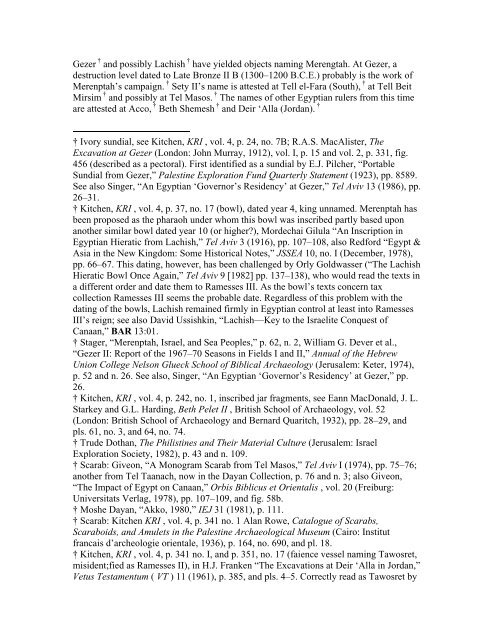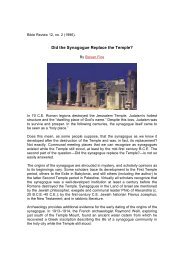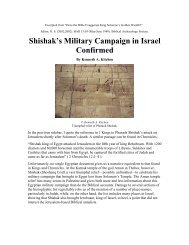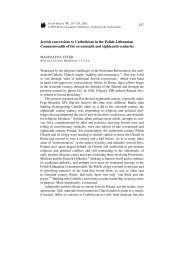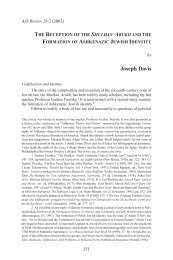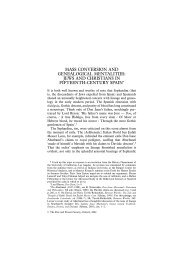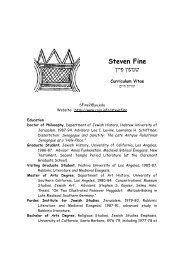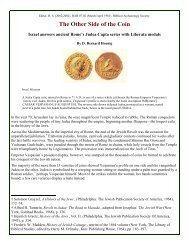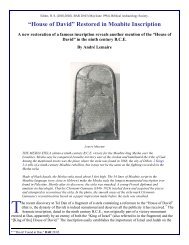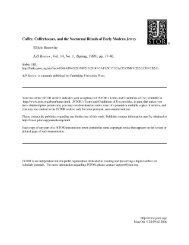3200-Year-Old Picture of Israelites Found in Egypt
3200-Year-Old Picture of Israelites Found in Egypt
3200-Year-Old Picture of Israelites Found in Egypt
Create successful ePaper yourself
Turn your PDF publications into a flip-book with our unique Google optimized e-Paper software.
Gezer † and possibly Lachish † have yielded objects nam<strong>in</strong>g Merengtah. At Gezer, a<br />
destruction level dated to Late Bronze II B (1300–1200 B.C.E.) probably is the work <strong>of</strong><br />
Merenptah’s campaign. † Sety II’s name is attested at Tell el-Fara (South), † at Tell Beit<br />
Mirsim † and possibly at Tel Masos. † The names <strong>of</strong> other <strong>Egypt</strong>ian rulers from this time<br />
are attested at Acco, † Beth Shemesh † and Deir ‘Alla (Jordan). †<br />
† Ivory sundial, see Kitchen, KRI , vol. 4, p. 24, no. 7B; R.A.S. MacAlister, The<br />
Excavation at Gezer (London: John Murray, 1912), vol. I, p. 15 and vol. 2, p. 331, fig.<br />
456 (described as a pectoral). First identified as a sundial by E.J. Pilcher, “Portable<br />
Sundial from Gezer,” Palest<strong>in</strong>e Exploration Fund Quarterly Statement (1923), pp. 8589.<br />
See also S<strong>in</strong>ger, “An <strong>Egypt</strong>ian ‘Governor’s Residency’ at Gezer,” Tel Aviv 13 (1986), pp.<br />
26–31.<br />
† Kitchen, KRI , vol. 4, p. 37, no. 17 (bowl), dated year 4, k<strong>in</strong>g unnamed. Merenptah has<br />
been proposed as the pharaoh under whom this bowl was <strong>in</strong>scribed partly based upon<br />
another similar bowl dated year 10 (or higher?), Mordechai Gilula “An Inscription <strong>in</strong><br />
<strong>Egypt</strong>ian Hieratic from Lachish,” Tel Aviv 3 (1916), pp. 107–108, also Redford “<strong>Egypt</strong> &<br />
Asia <strong>in</strong> the New K<strong>in</strong>gdom: Some Historical Notes,” JSSEA 10, no. I (December, 1978),<br />
pp. 66–67. This dat<strong>in</strong>g, however, has been challenged by Orly Goldwasser (“The Lachish<br />
Hieratic Bowl Once Aga<strong>in</strong>,” Tel Aviv 9 [1982] pp. 137–138), who would read the texts <strong>in</strong><br />
a different order and date them to Ramesses III. As the bowl’s texts concern tax<br />
collection Ramesses III seems the probable date. Regardless <strong>of</strong> this problem with the<br />
dat<strong>in</strong>g <strong>of</strong> the bowls, Lachish rema<strong>in</strong>ed firmly <strong>in</strong> <strong>Egypt</strong>ian control at least <strong>in</strong>to Ramesses<br />
III’s reign; see also David Ussishk<strong>in</strong>, “Lachish—Key to the Israelite Conquest <strong>of</strong><br />
Canaan,” BAR 13:01.<br />
† Stager, “Merenptah, Israel, and Sea Peoples,” p. 62, n. 2, William G. Dever et al.,<br />
“Gezer II: Report <strong>of</strong> the 1967–70 Seasons <strong>in</strong> Fields I and II,” Annual <strong>of</strong> the Hebrew<br />
Union College Nelson Glueck School <strong>of</strong> Biblical Archaeology (Jerusalem: Keter, 1974),<br />
p. 52 and n. 26. See also, S<strong>in</strong>ger, “An <strong>Egypt</strong>ian ‘Governor’s Residency’ at Gezer,” pp.<br />
26.<br />
† Kitchen, KRI , vol. 4, p. 242, no. 1, <strong>in</strong>scribed jar fragments, see Eann MacDonald, J. L.<br />
Starkey and G.L. Hard<strong>in</strong>g, Beth Pelet II , British School <strong>of</strong> Archaeology, vol. 52<br />
(London: British School <strong>of</strong> Archaeology and Bernard Quaritch, 1932), pp. 28–29, and<br />
pls. 61, no. 3, and 64, no. 74.<br />
† Trude Dothan, The Philist<strong>in</strong>es and Their Material Culture (Jerusalem: Israel<br />
Exploration Society, 1982), p. 43 and n. 109.<br />
† Scarab: Giveon, “A Monogram Scarab from Tel Masos,” Tel Aviv I (1974), pp. 75–76;<br />
another from Tel Taanach, now <strong>in</strong> the Dayan Collection, p. 76 and n. 3; also Giveon,<br />
“The Impact <strong>of</strong> <strong>Egypt</strong> on Canaan,” Orbis Biblicus et Orientalis , vol. 20 (Freiburg:<br />
Universitats Verlag, 1978), pp. 107–109, and fig. 58b.<br />
† Moshe Dayan, “Akko, 1980,” IEJ 31 (1981), p. 111.<br />
† Scarab: Kitchen KRI , vol. 4, p. 341 no. 1 Alan Rowe, Catalogue <strong>of</strong> Scarabs,<br />
Scaraboids, and Amulets <strong>in</strong> the Palest<strong>in</strong>e Archaeological Museum (Cairo: Institut<br />
francais d’archeologie orientale, 1936), p. 164, no. 690, and pl. 18.<br />
† Kitchen, KRI , vol. 4, p. 341 no. I, and p. 351, no. 17 (faience vessel nam<strong>in</strong>g Tawosret,<br />
misident;fied as Ramesses II), <strong>in</strong> H.J. Franken “The Excavations at Deir ‘Alla <strong>in</strong> Jordan,”<br />
Vetus Testamentum ( VT ) 11 (1961), p. 385, and pls. 4–5. Correctly read as Tawosret by


